Henry Noltie
Introduction
In 1823 Robert Brown published an account of the plants collected on Melville Island in the Canadian Arctic during the first voyage (1819–20) commanded by William Edward Parry in search of the elusive North-West Passage on the ship Hecla. (The plants were collected by Parry himself, the astronomer Edward Sabine, the surgeon John Edwards and his assistant Alexander Fisher, and James Ross; there are many duplicates in the RBGE herbarium). Brown, for the title of his account, instead of using the conventional Latin name of the goddess of flowers as a ‘Flora’, used her Greek equivalent Chloris, and called his work Chloris Melvilliana. It therefore seems appropriate to maintain this usage for an LMF (Local Micro Flora) of a street named for the same man as the island. From his position as First Lord of the Admiralty, Parry’s voyage was commissioned by Robert Saunders Dundas (1771–1851) the second Viscount Melville. It is he (rather than, as commonly believed, his father Henry) who is commemorated in Melville Street, planned and designed for the Walker family by a quite different (architectural) Robert Brown in 1814. After Melville’s death a fine statue of him by John Steell was in 1857 placed at the centre of the street, at the point where it dilates on either side into the double-sided Melville Crescent (actually a diagonal square) whose plants are included in the present account.

To the field botanist the street, one of the grandest and least altered in Edinburgh, the centre-piece of its Western New Town, is not a promising area for investigation. Standing at either end of its 366 metre length hardly a single blade of greenery is to be seen; its glories are entirely architectural. Blocking its western extremity rise the majestic façade and triple spires of Gilbert Scott’s 1870s Episcopal Cathedral of St Mary, which gives a surreal Gothic termination to an otherwise classical vista. The street’s eastern end benefits from a ‘borrowed view’: Robert Reid’s 1811–14, austere (almost Russian) dome of the former St George’s Church (now West Register House, part of the National Archives of Scotland), which actually stands between Charlotte Square and Randolph Place. Between this pair of Gothic and Classical ecclesiastical eyecatchers lie what were built as domestic dwellings for minor Scottish gentry and upper-end Edinburgh professionals. There are five extensive terraces, with the slightly later interruption of the Crescent already described, of three-storey-plus-basement houses, spaced 33 metres apart, with tenement blocks at the eastern and western ends (the north-eastern one is home to the author) and on the two corners of Stafford Street. The houses are set back about three metres from the pavement, behind sunken and paved ‘areas’ down flights of stairs, the drop from the pavement protected by iron railings; the front doors are approached by arched and paved stone bridges each of which is spanned by an elegant, cast-iron lamp arch. (The restoration of the stonework and ironmongery of the whole ensemble was an early success story in the restoration of the New Town; the lamps themselves were sadly never replaced, and the pavements have recently been replaced with nasty, multi-coloured, concrete slabs). Nearly all of the former houses are now used as offices, which means that there has been very little attempt to soften the stone by means of vegetation, with only a single handful of window-boxes, and a few pairs of tubs with bonsai bay and box trees. In two of the basement areas an attempt at gardening has been made: from one emerges some jasmine and Hydrangea petiolaris, and from the other the pale-green, triffid-tentacles of an Akebia. The asphalt, concrete, Carboniferous sandstone and lime mortar provide a challenging habitat for plant growth – the major stress must be an acute shortage of water, which quickly runs off both the vertical and horizontal surfaces into gutters and drains.

Method and area included
The plants were observed during a thirty-minute walk on the morning of 6 May 2020. I perambulated first along the north side of the street from east to west, then returned on the south side in the opposite direction. The plants grew in the gutters, cracks in the pavement, and on the walls, stone steps and paving of the ‘areas’. The weed flora of the northern side of the street is presently richer than that of the southern (though 11 species were seen only on the latter), but this is probably a reflection only of quirks of recent management.
A repeat survey later in the season will be necessary. Even if no weed-killing takes place, many ephemerals (e.g. Erophila verna) will soon have disappeared. Other species might, however, put in an appearance. Grasses are currently notably rare (only two species) and more may, with other perennials, perhaps become apparent later in the season.
Results
A total of 55 species were recorded: 6 ferns and 49 angiosperms.
Discussion
Status: native, archaeophyte, neophyte
Given that the habitat is entirely man-made – the question of ‘nativeness’ is rather meaningless, as all the plants must be relatively recent arrivals. Whereas some on area walls might be able to persist for reasonably lengthy periods, those on the pavements have been subject to repeated spraying by weed killer or manual removal, and must represent repeat colonisers. Nevertheless, one can at least give the status of the species in the country as a whole, from which these recent recruits have been made. Perhaps surprisingly a large majority (39) are native, 5 are ‘archaeophytes’ (apparently native, but ancient introductions), and only 11 are recent arrivals to these shores (‘neophytes’) – better known as aliens, which have been introduced either accidentally or, in some cases, as ornamentals. However, in Melville Street some plants cross these boundaries of status: the tutsan, while native in western Britain, must here, like wall-pepper, be a garden escape. The case of the native Danish scurvy-grass will be discussed later; the Welsh poppy, white stonecrop and feverfew, though counted as archaeophytes, must here also be regarded as garden escapes, as are the yellow corydalis and trailing bellflower that are denoted as neophytes.
Life forms
Given the acute water shortage of the habitat, and the climatic regime of slightly damper winters, it might have been expected that annuals would predominate, but this is not the case: of the 55 species recorded only 17 are annual. The roots of the 38 perennials clearly manage to find enough water in the cracks between paving stones and retaining walls, though many are probably short-lived. The same applies to the single shrubby species (the now ubiquitous butterfly bush), though none of its several individuals is more than a metre tall. Both of the trees recorded are represented only by single individuals: the birch, in a gutter, is a seedling with a very short life expectancy; the elm is embedded in the wall of a basement area and is less than a metre tall.
The salt-lovers or halophytes
With the winter salting of motorways, roads, streets and pavements plants of the coast and the saltmarsh have, over the last four decades, been able hugely to extend their range inland. Three such species are to be found in Melville Street, though not so frequently as in nearby Moray Place or the Dean Bridge – these are Danish scurvy-grass, lesser sea-spurrey and sea pearlwort.
Species of note
The most unexpected find was the glossy, evergreen fern, black spleenwort, Asplenium adiantum-nigrum, with healthy colonies on two sections of the inward (east- and north-facing) area walls of No. 23, growing along with the much commoner A. trichomanes.
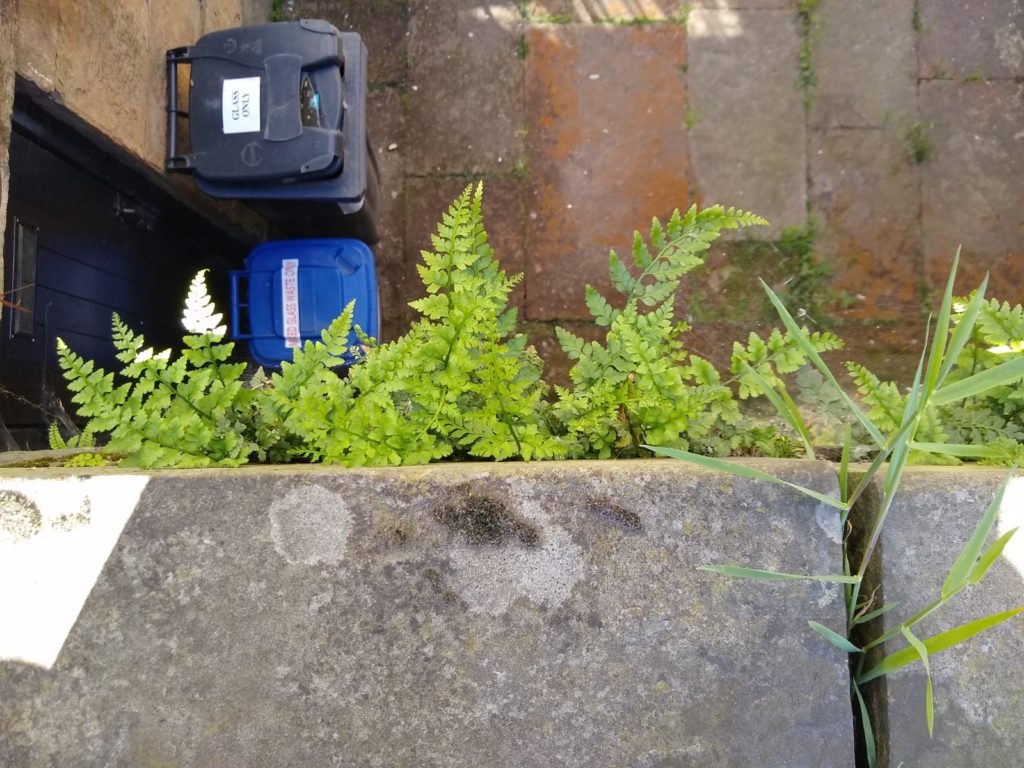
In recent years the grass Polypogon viridis has become very common in Melville Street and on the nearby Dean Bridge. Classed as a neophyte, it was first recorded in cultivation in Britain in 1800 and in the wild in Cardiff in 1876. Until about twenty years ago, its British spread was limited to England northwards to Norfolk, but since then it has greatly extended its range. Not normally regarded as a halophyte it must certainly be salt tolerant to survive very close to the road.
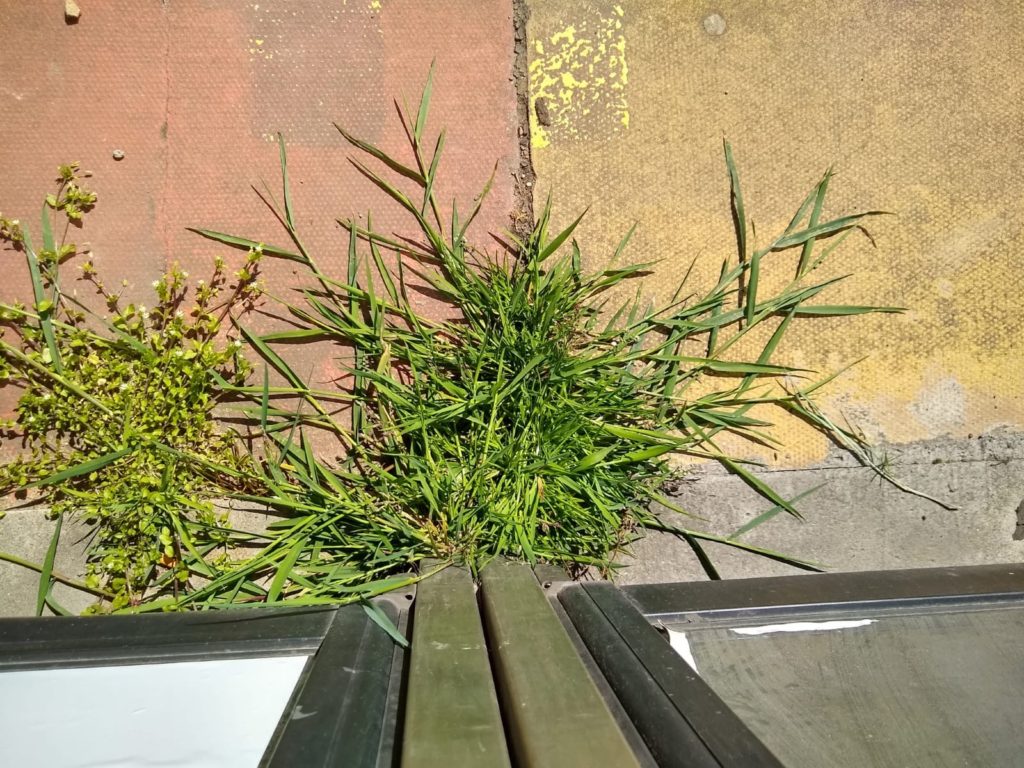
Perhaps the most intriguing of the plants is a species of Sedum that I have noticed for at least five years on the pavement directly beneath my flat and on the opposite side of Melville Street, but which has never flowered. A small, compact, perennial, it has attractive, slightly glaucous, glandular leaves and Ray Stephenson has identified it as the Central European form of S. dasyphyllum, which is hardy and grows up to the snowline in the Pyrenees. It has been recorded as naturalised between Jersey and Yorkshire, but this is the furthest north he has heard of it, which perhaps explains its reluctance to flower. The plant can grow from a single leaf (and these detach with the greatest of ease) and is spread by birds. Although cultivated at RBGE it is certainly not a common plant in Edinburgh gardens and I wonder if its origin might lie in the recent craze for ‘green roofs’, on which, due to their drought tolerance, various species of Sedum form major components.
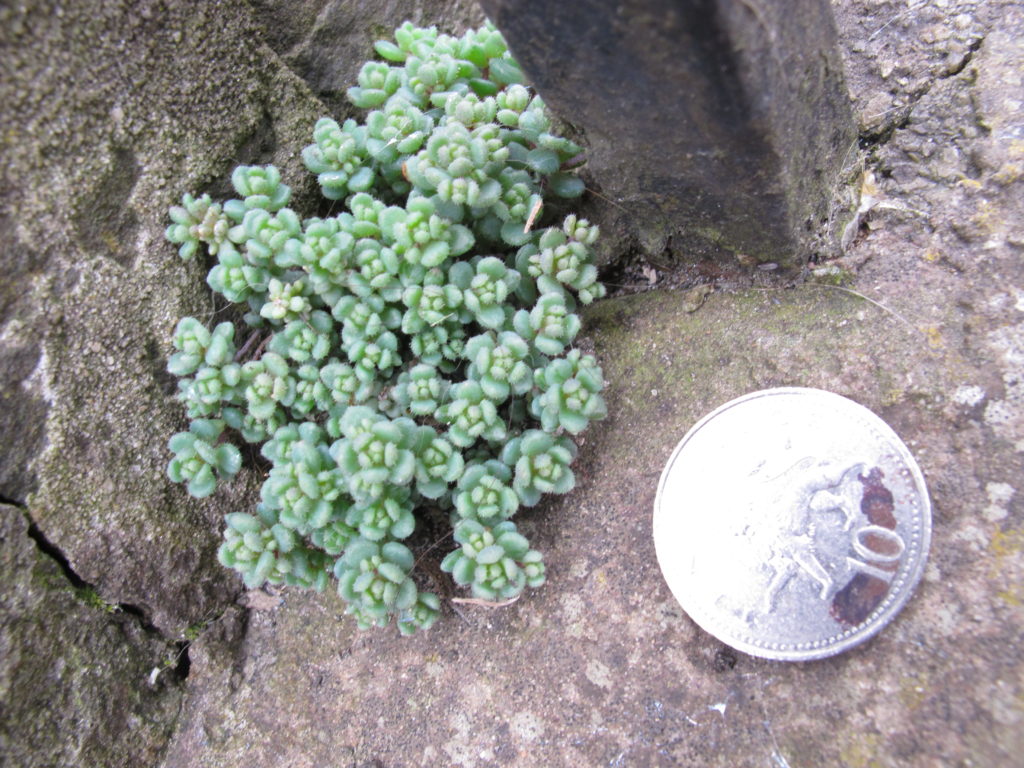
It is one of the halophytes, Sagina maritima, that I am particularly pleased to see and grows directly below my dining-room window, as it has connections with George Don and my adoptive county, Angus. It was described as a species for the first time by Don in his Herbarium Britannicum, a collection of dried specimens for which his friend Patrick Neill printed the title-pages and labels. The Sagina is the only one of the three species described by Don (the others being Myosotis alpina and Raphanus maritimus) under his name. The sea pearlwort was specimen No. 155, issued in 1806, which he reported from ‘on the sea coast not unfrequent, in Angusshire, Isle of Sky, near Aberdeen, Queensferry and Edinburgh’. Don might have been rather surprised by its recent spread.
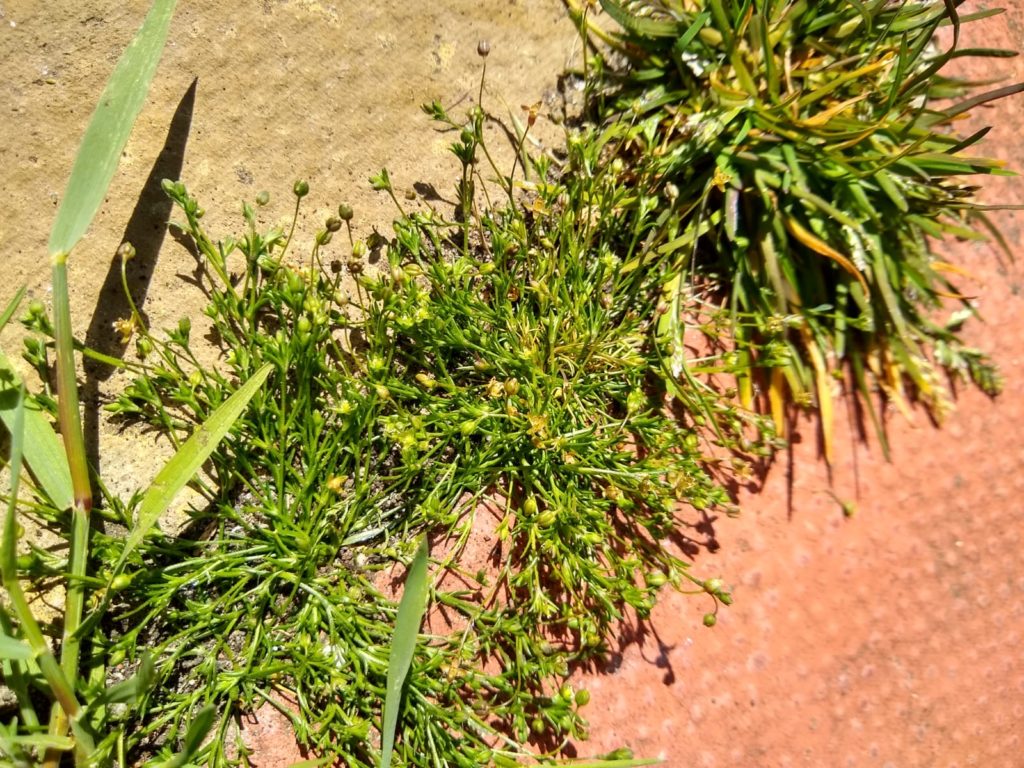
I devoted three happy years of my life, working with Ruth Ingram in St Andrews, to the cytology of the genus Senecio. The project was on S. cambrensis, a fertile hybrid derivative of the groundsel and the Oxford ragwort that first arose, as a new species, in North Wales probably relatively shortly before its discovery in 1948. The species however evolved, independently, for a second time in Leith, as discovered during the course of my project in the early 1980s (but now sadly extinct there). Not only are the bright yellow daisies (radiate capitula) of the Oxford ragwort an adornment to any city street, but it has an interesting story and a connection with both George Don and RBGE. The story of its spread from the Oxford Botanic Garden is well known. The plant is believed to have originated on the slopes of Mount Etna in Sicily as a hybrid between Senecio aethnensis and S. chrysanthemifolius and was introduced to the Oxford Botanic Garden around 1690. By the 1780s, when George Don observed it on one of his travels ‘in the neighbourhood of Oxford’, it had already broken out. Thereafter it spread rapidly, especially with the development of the railway system (the ballast of the tracks must have reminded it of its native lava). There is a well-known story of how George Claridge Druce once observed some cypselae (achenes with feathery pappuses) ‘enter a railway-carriage near Oxford and remain suspended in the air in the compartment until they found an exit at Tilehurst’. It turns out, from a sheet in the herbarium of George Walker-Arnott at RBGE, that the plant had at least two potential independent sources of introduction to Scotland long before the relentless northward march from Oxford. The sheet bears two collections, both regrettably undated – one is labelled ‘naturalized at the back of Don’s garden, Forfar’, the other ‘Old Botc. Garden [almost certainly the Leith Walk Garden]’. The Edinburgh garden moved to Inverleith in the early 1820s, and Walker-Arnott is known to have visited Don’s former garden around 1824, when it was under the care of Thomas Drummond, so both specimens perhaps date from the mid 1820s. Don had in fact distributed specimens of Senecio squalidus in 1806 as No 140 of his Herbarium Britannicum, but these were stated to come from ‘a garden’, which could have been either his own in Forfar, or the Leith Walk one of which he was superintendent c. 1802–8.
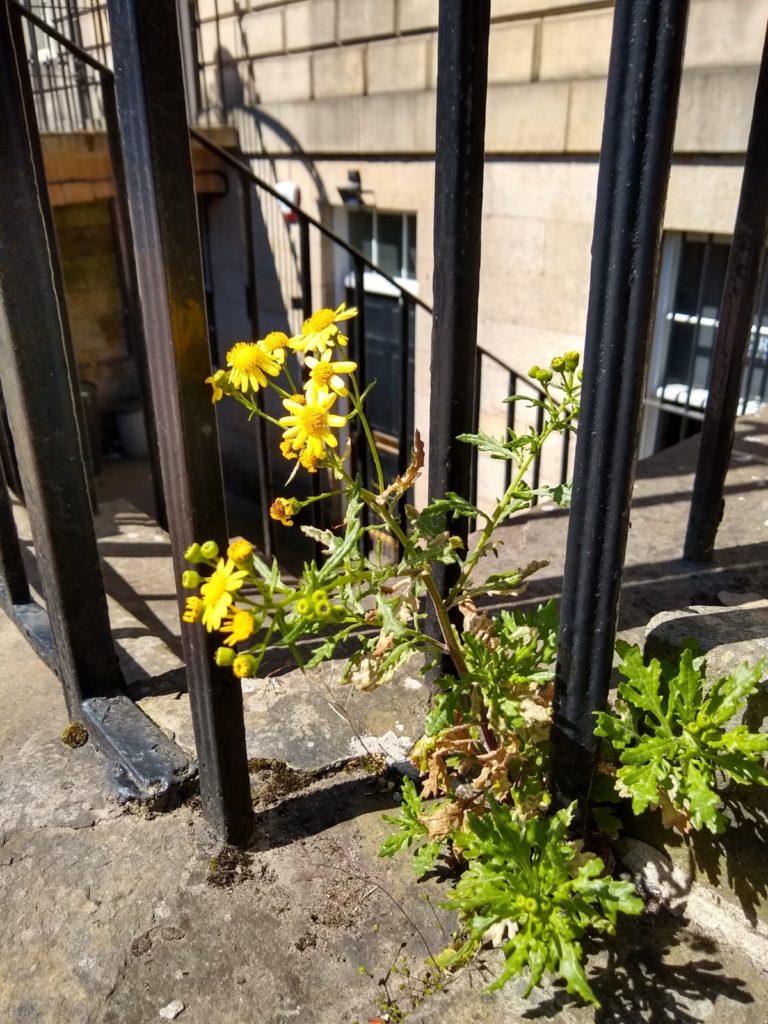
Systematic list
Being the work of a botanical dinosaur the arrangement follows the families and order of ‘CTW’, though the species names have been updated.
Ferns
Black spleenwort (Asplenium adiantum-nigrum)
Wall rue (Asplenium ruta-muraria)
Hart’s-tongue (Asplenium scolopendrium) (S side of street only)
Maidenhair spleenwort (Asplenium trichomanes)
Broad buckler-fern (Dryopteris dilatata)
Male fern (Dryopteris filix-mas) (S side of street only)
Dicots
Papaveraceae
Welsh poppy (Papaver cambrica)
Yellow corydalis (Pseudofumaria lutea)
Cruciferae
Thale cress (Arabidopsis thaliana)
Wavy bitter-cress (Cardamine flexuosa)
Hairy bitter-cress (Cardamine hirsuta)
Danish scurvy-grass (Cochlearia danica) (S side of street only)
Common whitlow-grass (Erophila verna)
Hedge mustard (Sisymbrium officinale)
Hypericaceae
Tutsan (Hypericum androsaemum)
Caryophyllaceae
Common mouse-ear (Cerastium fontanum)
Sticky mouse-ear (Cerastium glomeratum)
Sea pearlwort (Sagina maritima)
Procumbent pearlwort (Sagina procumbens)
Lesser sea-spurrey (Spergularia marina)
Common chickweed (Stellaria media)
Oxalidaceae
Procumbent yellow-sorrel (Oxalis corniculata)
Crassulaceae
Wall-pepper (Sedum acre)
White stonecrop (Sedum album) (S side of street only)
Thick-leaved stonecrop (Sedum dasyphyllum)
Onagraceae
Rosebay willowherb (Chamaenerion angustifolium) (S side of street only)
Broad-leaved willowherb (Epilobium montanum)
Hoary willowherb (Epilobium parviflorum)
Short-fruited willowherb (Epilobium obscurum)
Urticaceae
Pellitory-of-the-wall (Parietaria judaica) (S side of street only)
Stinging nettle (Urtica dioica)
Ulmaceae
Wych elm (Ulmus glabra)
Betulaceae
Hybrid birch (Betula x aurata)
Buddlejaceae
Butterfly bush (Buddleja davidii)
Scrophulariaceae (in the old sense)
Ivy-leaved toadflax (Cymbalaria muralis)
Green field-speedwell (Veronica agrestis)
Plantaginaceae (in the old sense)
Greater plantain (Plantago major) (S side of street only)
Campanulaceae
Trailing bell-flower (Campanula poscharskyana)
Compositae
Daisy (Bellis perennis) (S side of street only)
Creeping thistle (Cirsium arvense) (S side of street only)
Argentine fleabane (Conyza cf. bonariensis)
Beaked hawk’s-beard (Crepis vesicaria subsp. taraxifolia)
Hawkweed (Hieracium sp.)
Cat’s-ear (Hypochaeris radicata) (S side of street only)
Pineappleweed (Matricaria discoidea)
Wall lettuce (Mycelis muralis)
Common ragwort (Senecio jacobaea)
Oxford ragwort (Senecio squalidus)
Groundsel (Senecio vulgaris)
Prickly sow-thistle (Sonchus asper)
Smooth sow-thistle (Sonchus oleraceus)
Feverfew (Tanacetum parthenium) (S side of street only)
Dandelion (Taraxacum officinale)
Coltsfoot (Tussilago farfara)
Monocots
Gramineae
Annual meadow-grass (Poa annua)
Water bent (Polypogon viridis)
Conclusion
I made a similar list on 19 June 2005, when 48 species were recorded, including 13 species not seen on the present occasion. These were bracken (Pteridium aquilinum) and the flowering plants Acer pseudo-platanus, Agrostis cf. scabra, Capsella bursa-pastoris, Fraxinus excelsior, Galium aparine, Geranium lucidum, Papaver somniferum, Polygonum aviculare, Rosa rugosa, Rumex obtusifolius, Sagina apetala, Salix caprea. Later in 2005 I also observed Trifolium repens.
If these are added to the present list, the number of species recorded for the Via Melvilliana comprises 7 ferns and 68 angiosperms. If the British flora (including archaeophytes, but excluding apomictic microspecies) is taken to number 1671 species, then this represents 4.5% of the total: surely rather a surprise for such an unpromising-looking urban site, with no visible soil, and a total area of only about 1.2 hectares.
Acknowledgements
My thanks are due to Sir Launcelot Henderson, who suggested the placement of a crucial hyphen in the title; Professor David Mabberley, who got me to buck up my ideas regarding some of the species names (but is not responsible for my attachment to old families); and Ray Stephenson for his identification of, and interesting information about, Sedum dasyphyllum.
